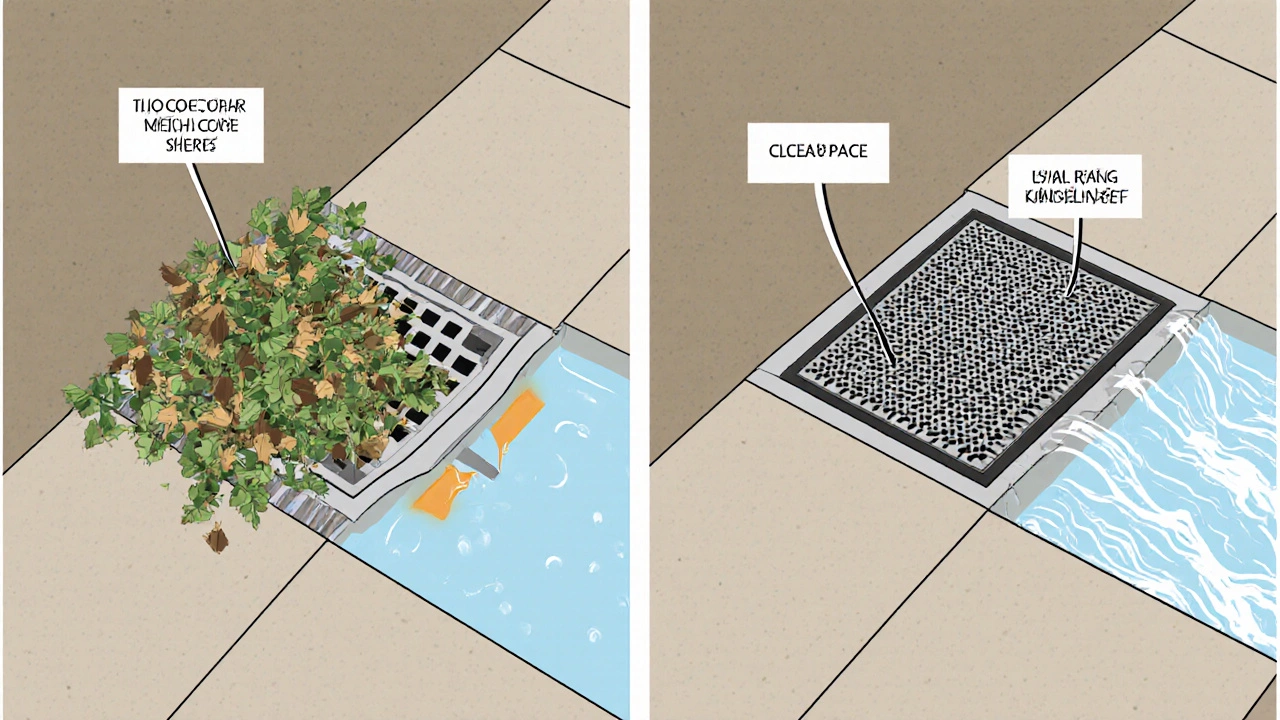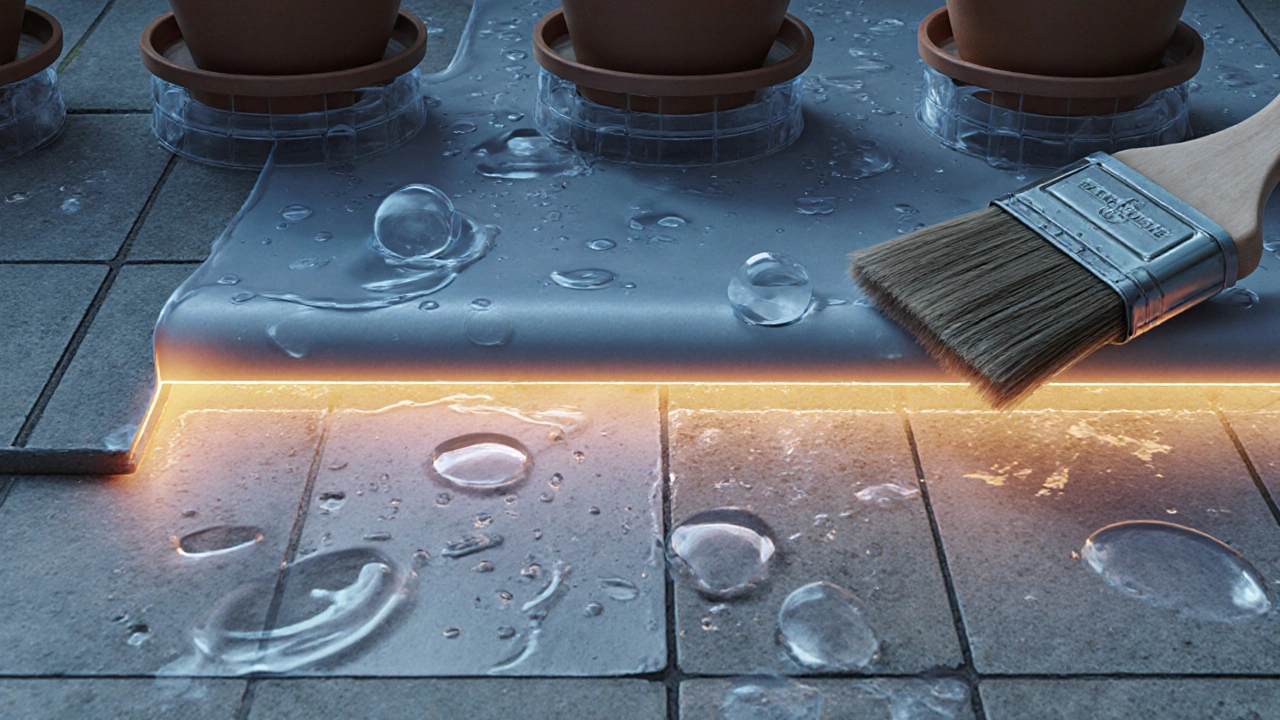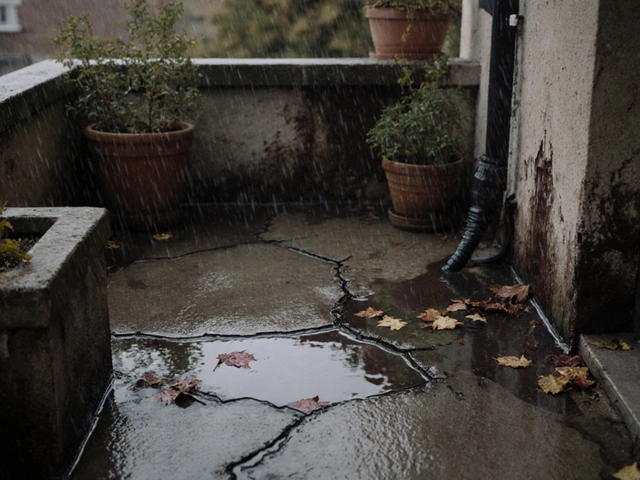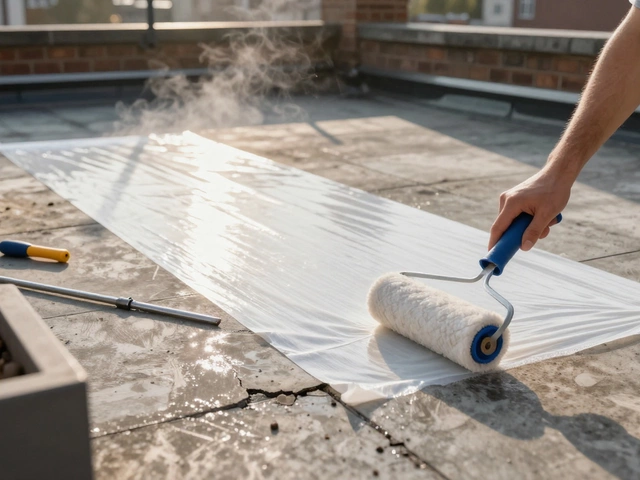If your terrace is leaking, you’re not just dealing with a messy floor or stained walls-you’re risking structural damage to your home. Water seeping through cracks, poor drainage, or failed waterproofing doesn’t just ruin your plants and pots. It can rot wooden beams, weaken concrete, and even leak into your neighbor’s apartment below. In Brighton, where rain is frequent and winters are damp, this isn’t a rare problem. It’s a common one. And the good news? Most terrace leaks are fixable without tearing everything apart.
Find Where the Water Is Coming From
You can’t fix a leak if you don’t know where it’s hiding. Start by watching where water pools after rain. Look for dark patches on the ceiling below, peeling paint on walls, or mold growing near corners. These are your clues.
Most terrace leaks come from one of three places:
- Cracks in the flooring-especially around planters, drains, or where tiles meet walls
- Failing waterproof membrane-the layer under tiles or pavers that’s supposed to keep water out
- Blocked or broken drains-if water can’t flow away, it backs up and finds a way through
Try this simple test: after a dry day, pour a bucket of water near the edge of your terrace. Watch where it goes. If it flows toward the wall or collects in one spot, that’s your problem zone. Don’t guess-track it.
Clear and Clean the Drainage System
A clogged drain is the #1 cause of terrace leaks. Leaves, soil, and plant debris build up over time and block the outlet. In Brighton, where wind blows in wet leaves from nearby trees, this happens fast.
Here’s how to fix it:
- Remove any planters, pots, or furniture covering the drain.
- Use a shop vacuum or a long-handled brush to pull out debris.
- Flush the drain with a hose. If water doesn’t flow freely after 30 seconds, the pipe is likely clogged deeper.
- If you can’t clear it yourself, call a plumber. A small camera inspection costs less than repairing water damage later.
Pro tip: Install a drain cover made of stainless steel or plastic mesh. It stops leaves and soil from getting in but lets water through. Replace it every year before autumn.
Repair Cracks and Gaps
Even hairline cracks let water through. Over time, freeze-thaw cycles in winter make them worse. If you have tiled or concrete terrace, check every joint between tiles, around planters, and where the terrace meets the wall.
For small cracks (under 3mm wide), use a flexible polyurethane sealant like SikaFlex or CT1. These stay elastic when they dry, so they won’t crack again when the terrace expands or contracts. Don’t use regular silicone-it turns brittle and fails fast outdoors.
For wider gaps or broken tiles:
- Remove damaged tiles or concrete chunks.
- Clean the area with a wire brush and let it dry completely.
- Fill with a rapid-set repair mortar like Quick-Set Concrete.
- Seal the edges with waterproof sealant after 24 hours.
Don’t just patch the crack-seal the whole area around it. Water doesn’t travel in straight lines. It finds the weakest point, and that’s often right next to where you see the damage.

Reapply Waterproofing (The Real Fix)
If you’ve tried clearing drains and sealing cracks but water still gets through, your waterproof membrane is gone. This is the layer that should be under your tiles or pavers. Most terraces built before 2015 used bitumen-based membranes. They dry out, crack, and fail after 10-15 years.
You don’t need to rip up your entire terrace. Here’s how to fix it without a full rebuild:
- Remove loose tiles, dirt, and old sealant. Sweep and pressure wash (low setting) to clean the surface.
- Let it dry for at least 48 hours. Moisture trapped under new coating causes bubbles and peeling.
- Apply a liquid waterproof membrane like WATERPROOF 2000 or Flex Seal Liquid. These are brush-on or roll-on coatings made for outdoor use.
- Apply two coats, letting each dry for 12 hours. Pay extra attention to corners, drains, and edges.
- Wait 72 hours before placing pots or walking on it.
This method works even over old tiles. It bonds to concrete, ceramic, and even some plastics. It’s not as strong as a full membrane replacement, but it lasts 5-8 years and costs under £150 for a 10m² terrace.
Protect Your Plants Without Damaging the Terrace
If you garden on your terrace, you’re probably using pots. But pots sitting directly on the surface trap moisture, create pressure points, and cause slow leaks. Even with drainage holes, water wicks up through the base and saturates the terrace below.
Here’s how to protect both your plants and your terrace:
- Use pot feet or plastic risers under every pot. These lift the pot 1-2cm off the surface, letting water drain freely.
- Place pots on plastic saucers with drainage holes. Empty them after rain-standing water is a hidden leak source.
- For large planters, install a drainage layer of gravel or broken pottery at the bottom. This reduces how much water presses down on the terrace.
- Avoid planting directly into the terrace surface. Even raised beds need a barrier. Use a waterproof liner underneath.
One gardener in Hove had mold growing under her flower boxes for two years. She thought it was damp soil. It was water trapped by the boxes sitting flat on the terrace. Once she lifted them with pot feet, the mold disappeared in a week.

Prevent Future Leaks Before They Start
Fixing leaks is expensive. Preventing them is cheap. Here’s your yearly checklist:
- Spring: Clean drains, check for new cracks, reseal edges.
- Summer: Move pots occasionally to prevent staining and trapped moisture.
- Autumn: Clear leaves from drains and surfaces. Install mesh covers.
- Winter: Avoid using salt or de-icers on the terrace. They eat away at sealants and concrete.
Every two years, inspect your waterproofing. If the surface looks dull, chalky, or flaky, it’s time to reapply. Don’t wait for water to appear on your ceiling.
When to Call a Professional
You can handle 90% of terrace leaks yourself. But if you see any of these signs, stop and call a specialist:
- Water is dripping from the ceiling below your terrace
- Plaster is bulging or crumbling
- You hear water running inside the wall
- More than 20% of your terrace has cracked or loose tiles
A structural surveyor or waterproofing specialist can use moisture meters and infrared cameras to find hidden leaks. They can also install a full membrane if needed. It’s more expensive-£800-£2,500-but it lasts 20+ years.
Don’t ignore these signs. A small leak today can become a £10,000 repair tomorrow.
Can I use regular paint to waterproof my terrace?
No. Regular interior or exterior paint isn’t designed to handle standing water or foot traffic. It will peel, crack, and trap moisture underneath. Use only products labeled as ‘liquid waterproof membrane’ or ‘terrace waterproof coating.’ Brands like SikaFlex, CT1, or WATERPROOF 2000 are made for this.
How often should I reseal my terrace?
Every 3-5 years if you have a liquid membrane, or every 8-10 years if you have a full sheet membrane. But check every spring. If the surface looks dry, chalky, or faded, it’s losing its protection. A quick re-coat can double its life.
Why does my terrace leak only in winter?
Cold weather doesn’t cause leaks-it reveals them. Water freezes in cracks and expands, making them wider. When it thaws, more water gets in. Also, melting snow adds extra pressure. If your terrace leaks only in winter, the problem is likely small cracks or a failing membrane that can’t handle the extra volume.
Is it safe to plant directly in the terrace soil?
No. Even if you dig a small bed into the terrace, water from watering and rain will soak into the structure below. Always use containers with drainage and place them on risers. If you want a garden bed, build it on top of a waterproof liner and add a gravel base underneath.
Will a waterproof coating work on a wooden terrace?
Not directly. Wood expands and contracts with moisture, so liquid coatings will crack. For wooden terraces, use a flexible membrane like EPDM rubber sheeting underneath the decking, or install a raised platform with drainage gaps. Seal the wood with a marine-grade varnish, but never rely on paint alone.
Next Steps: What to Do Today
Don’t wait for the next storm. Here’s your action plan:
- Go outside and inspect your terrace. Look for cracks, mold, or pooling water.
- Clear the drain. Remove leaves and flush with water.
- Lift two or three pots. Check if water is trapped underneath.
- If everything looks dry and clean, apply a waterproof sealant to high-risk areas (edges, drains, corners).
- Set a reminder: one year from today, check again.
Stopping a terrace leak isn’t about expensive renovations. It’s about attention. Small fixes, done on time, stop big problems before they start. Your terrace, your plants, and your downstairs neighbor will thank you.



